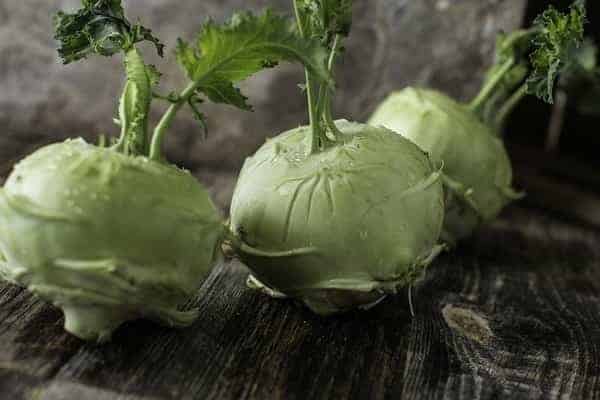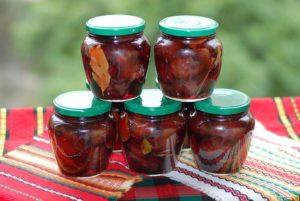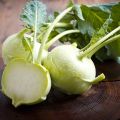Recipes for cooking kohlrabi cabbage for the winter with and without sterilization
Kohlrabi is an unpretentious and vitamin-rich vegetable that anyone can grow in their own garden. In our country, he has not yet received proper recognition, while in Europe he is known everywhere and is eaten with pleasure.
Kohlrabi is very similar to turnips, but in fact it is one of varieties of white cabbage, which has a high content of vitamin C. Let's see why kohlrabi is so useful, how to grow it, and what recipes for cooking for the winter exist.

Useful properties of kohlrabi
Every person who tries a product for the first time is interested not only in taste, but also in the benefits that it will bring to the body. Eating kohlrabi will help the body in the following ways:
- Removes excess fluid from the body.
- Increases the level of hemoglobin in the blood.
- Normalizes bowel function, accelerating the process of processing and assimilation of food.
- Cleans the kidneys, removing substances that interfere with their work.
- Helps in cleaning blood vessels from excess cholesterol.
- Stimulates the stomach.
- Reduces the risk of stroke.
- It is used to reduce the risk of bowel cancer.
- Helps relieve constipation.

Note! You can eat the whole vegetable, including the leaves. It is very convenient and economical.
Kohlrabi should be included in the diet:
- people suffering from heart and blood vessel diseases;
- women during pregnancy and mothers who are breastfeeding;
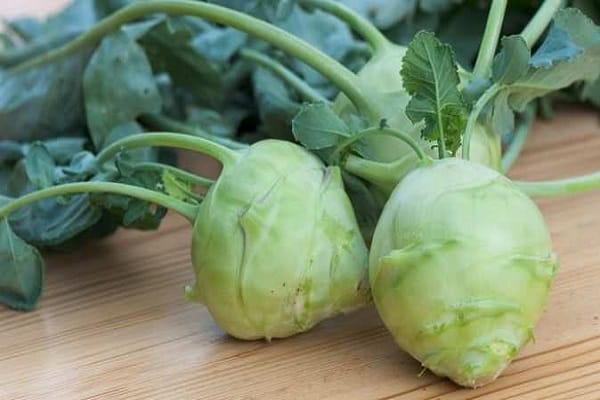
Do not eat kohlrabi if you have:
- aggravated pancreatitis;
- stomach ulcer;
- duodenal ulcer;
- low blood pressure;
- increased acidity of the stomach.
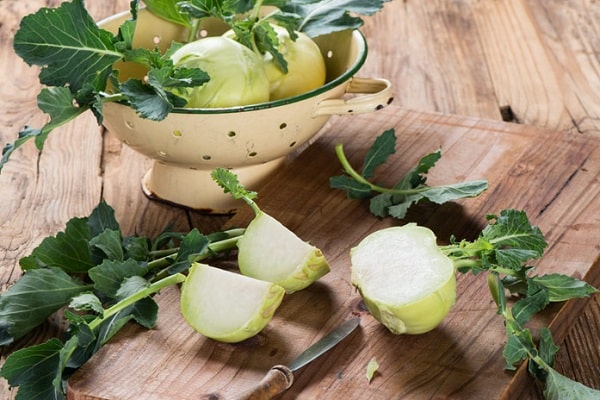
Preparing cabbage
In order to prepare the cabbage for conservation, follow these steps:
- rinse all vegetables thoroughly with water and dry them;
- before sending the kohlrabi for storage in the cellar, remove all the leaves from it and put it in a dense layer in a box, roots down;
- remove all damaged areas and those parts of the cabbage that have begun to rot.
After completing these steps, you can easily preserve the product and store it in a convenient place for you.

Recipes for preparations for the winter
Today, everyone will find many recipes for preparing kohlrabi for the winter. You can store it in the cellar, roll it up in jars for the winter, dry it, or simply store it in the refrigerator. Each method has its own advantages and disadvantages.
Below we will look at the most popular preservation methods to preserve the maximum benefit of the product.
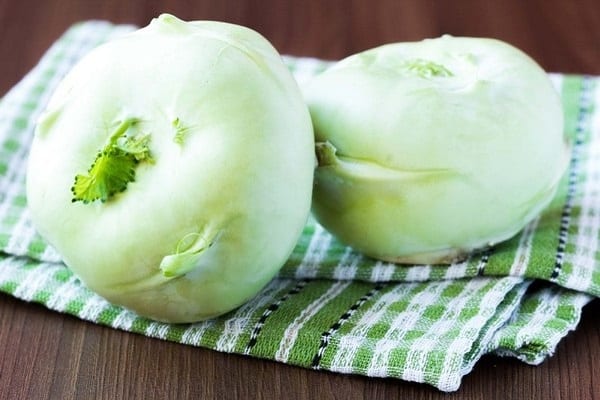
The secret to proper freezing
Kohlrabi is an unpretentious cabbage, and it is easy to store it, including by freezing. However, you need to know a few secrets that will allow you to do this more efficiently:
- The cabbage is washed thoroughly.
- The cabbage is blanched for 3 minutes and then cooled in cold water.
- Cut the finished vegetables into small pieces or grind them with a grater.
- We put the finished kohlrabi in plastic bags, close them tightly and send them for storage in the freezer.
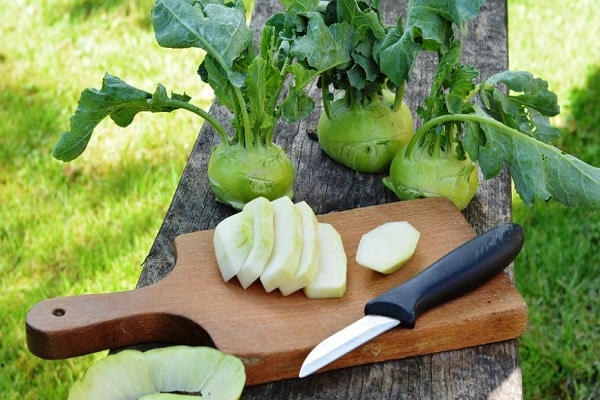
This method of conservation will preserve the beneficial properties of the product for 8-9 months.
There is another freezing method that can preserve the product for up to 3 weeks. To do this, wrap the head of cabbage with a damp towel or a piece of parchment. In this form, it is placed in a bag and, having released all the air, it is tightly closed. After packing the cabbage in the right way, you can safely send it to the refrigerator.

Winter salad with the addition of carrots and onions
For housewives who want to make a winter salad, the following recipe is perfect.
Ingredients:
- Cabbage - 600 grams.
- Garlic - 5 cloves.
- Pepper - 7 peas.
- Celery - 5 branches.
- Onion - 1 piece.
- Carrots - 200 grams.
- Water - 0.5 liters.
- Vinegar - 50 grams.
- Salt - half a tablespoon.
- Sugar - 50 grams.

Preparation:
- Add water and seasonings to a container set on fire. Boil the marinade over a fire for 8-9 minutes.
- Rinse vegetables thoroughly before cooking.
- After drying cabbage and carrots, rub with a grater.
- Chop the onion finely.
- Rinse jars and lids used for conservation with boiling water.
- Put celery and garlic in a jar.
- Then, in a dense layer, put a mixture of onions, carrots and cabbage in a jar.
- Fill in the marinade.
- We sterilize the jars.
- We roll up the covers.
- We put the cans upside down on a flat surface covered with dense fabric, and cover them with a blanket.
- We are waiting for the jars to cool down to room temperature, after which they can be removed to the cellar.
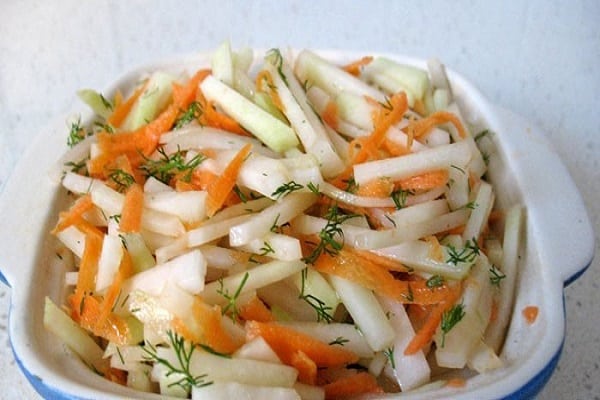
Dry kohlrabi
To dry kohlrabi, you will need:
- Remove the peel from the kohlrabi.
- Cut the head of cabbage into thin strips.
- The prepared product is blanched for 4 minutes.
- The strips are laid out on a pallet and dried.
- Next, the pallet is placed in an oven preheated to a temperature of 65 about, for 2-3 hours.
- During drying, the vegetable mass must be stirred periodically.
- The finished product is placed in plastic bags or glass jars and then sent to a dark, dry place.
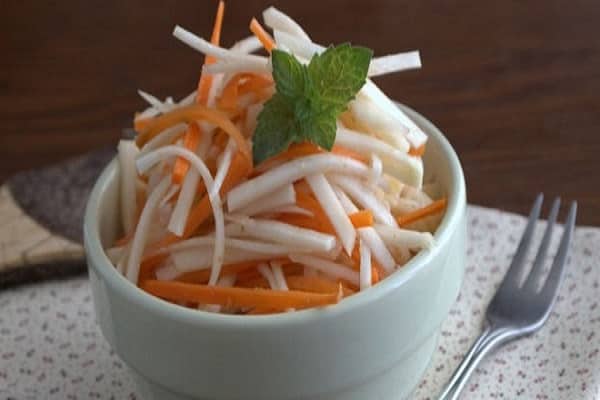
Salted pieces in Abkhazian style
Ingredients required for cooking:
- Cabbage - 5 kilos.
- Garlic - 40 grams.
- Salt - 150 grams.
- Celery sprigs - 4 pieces.
- Hot pepper - 80 grams.
- Blue fenugreek seeds - 30 grams.
- Water - 1 liter.

Salting cabbage is as follows:
- We wash the kohlrabi and cut it into small pieces.
- Remove the pepper seeds and chop it finely.
- Cut the peeled garlic cloves into 2-3 cloves.
- Put the finished ingredients tightly in a saucepan or other convenient container.
- Add seasoning.
- We place the container under oppression and leave it for salting for up to 30 days.
- We distribute the finished product in glass jars and close them.
- Jars are stored in a cool dark place.
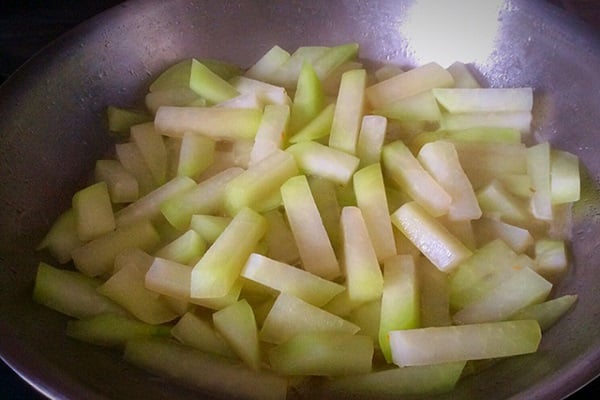
Canning kohlrabi
We preserve kohlrabi as follows:
- We take 3 kilograms of product, wash it, clean it and cut it into medium pieces.
- We boil a liter of water on a fire, diluting 1 tablespoon of salt in it.
- Add cabbage to boiling water and cook it for 5 minutes.
- Cool the resulting product and distribute it into sterilized containers.
- Cooking the brine. To do this, add a glass of vinegar and 30 grams of salt to one liter of boiling water.
- Pour the resulting liquid into jars and roll them up with lids.
- We sterilize the containers and send them for storage to the cellar.
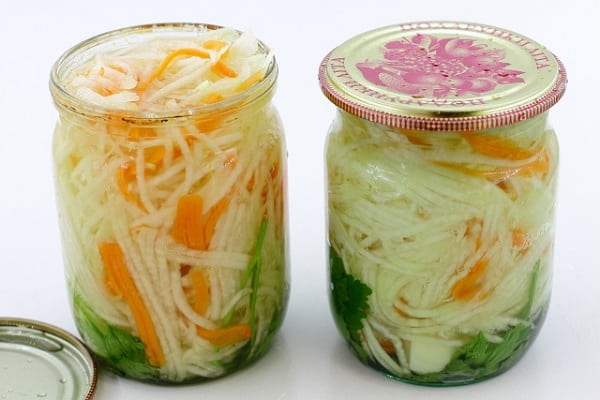
Method without sterilization
Housewives who do not have free time for sterilization can prepare a vegetable as follows:
- We take 1 kilogram of cabbage, 500 grams of sweet pepper, 450 grams of onions and a pound of carrots. Mine and clean them.
- Finely chop the onion into half rings.
- Peppers are cut into strips.
- Using a grater, grind the carrots with cabbage.
- We mix all the ingredients together and put them in sterile jars.
- Pour boiling water over the containers and let them brew for 2-3 minutes.
- We drain the liquid and boil it again.
- As soon as the water boils, pour it into containers again.
- Drain the water again, add 80 grams of vinegar, 400 grams of sugar and 150 grams of salt to it.
- For the third time we boil water and pour it into jars.
- Roll up the lids and turn the cans upside down until they cool completely.
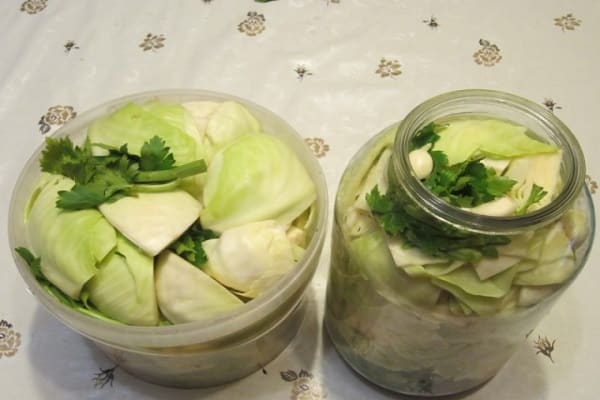
Marinated with beets
If you want to give a dish a bright and rich color - beets will help with this. Pickling takes place as follows:
- Take 1 kohlrabi.
- 5 bay leaves.
- 700 grams of beets.
- A head of garlic.
- Pepper - 8-10 peas.
- Litere of water.
- Three tablespoons of vinegar.
- 2 tablespoons of salt and sugar.
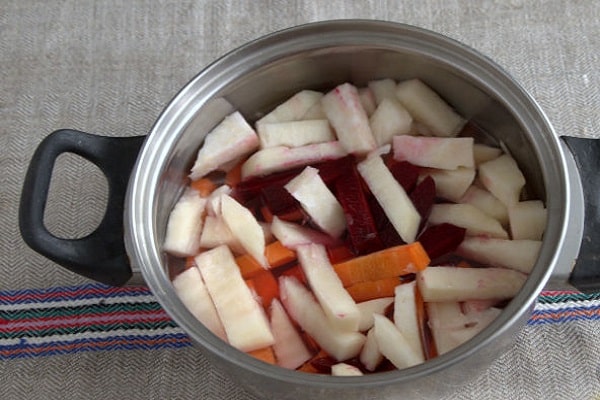
Having prepared the necessary ingredients, we proceed to the marinating process:
- We clean the beets and cook them for 40 minutes. Beets, during cooking, must be covered with a lid.
- Cook the peeled cabbage in a separate container for 5 minutes. Cut the finished product into small cubes.
- We sterilize jars for storing vegetables.
- Cooking the marinade. To do this, add vinegar, sugar and salt to boiling water.
- We put vegetables in jars, fill them with marinade, cover with a lid and send to sterilize.
- Chilled sterilized jars can be sent for storage in the cellar.
Note! If the cabbage is overripe, it is boiled for 15-20 minutes instead of 5 minutes.
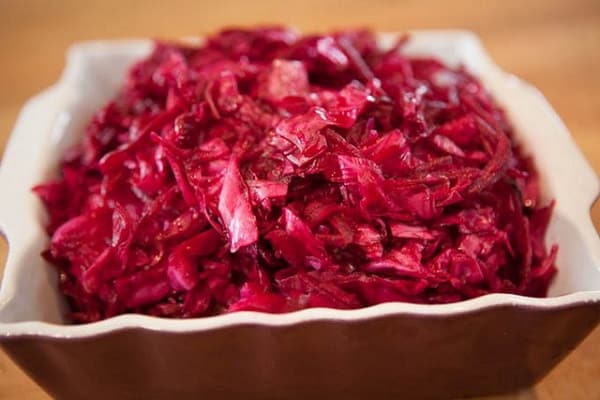
Pickled with herbs
A tasty and easy-to-prepare appetizer that will delight you and your guests. To make 2 cans of sauerkraut, you will need:
- 8 heads of cabbage;
- 4 cloves of garlic;
- dill - 4 tablespoons;
- 3 glasses of water;
- 2 tablespoons of salt;
- 2 tablespoons mustard seed
- half a teaspoon of red ground pepper.
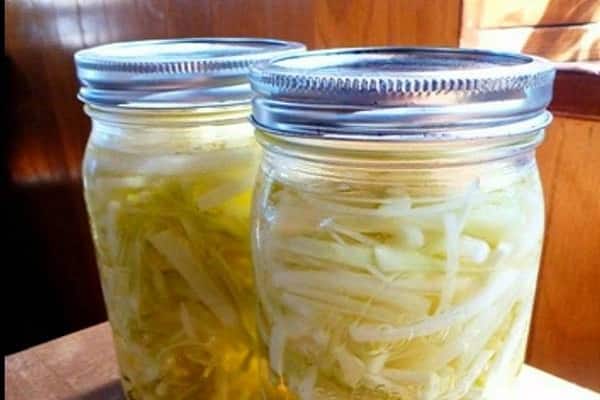
We clean the cabbage, wash it and dry it with a towel. The heads of garlic must also be peeled and rinsed. Cut the cabbage into thin strips. Choose the size of the cut yourself, based on your own preferences. We spread the chopped cabbage on the bottom of the jar in a thick layer and sprinkle it with dill. Sprinkle on top with another layer of cabbage and dill.
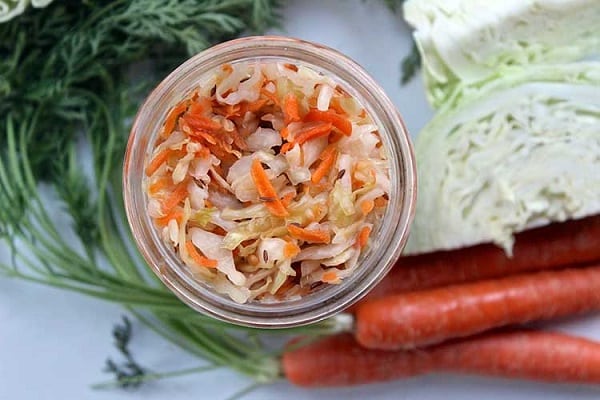
We repeat the procedure until a few centimeters of free space remain in the bank. It will be needed in order to pour the brine over the snack.
The brine is prepared in a separate container in which water, pepper, mustard and salt are mixed. Remember to stir the brine thoroughly. The resulting liquid is poured into jars and closed with a lid. In this state, the snack must be allowed to stand for at least 4 days, at room temperature. After the snack, you can eat it or put it in the basement.
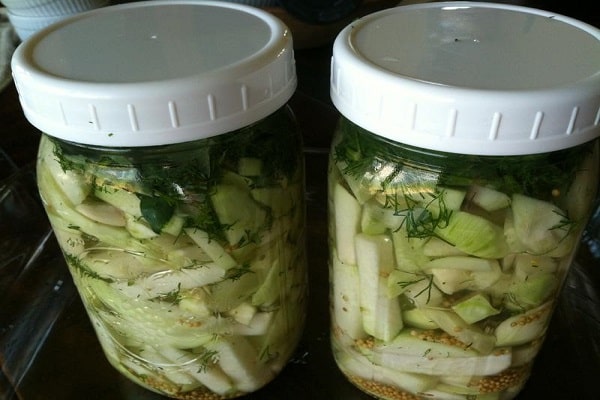
Storage conditions
You can store cabbage under the following conditions:
- In the cellar.
To do this, you need to remove the stems and leaves from the cabbage, and put the heads of cabbage in a dense layer in a box, roots down. You do not need to wash the vegetables; it is enough to shake them off the excess soil adhering to the roots. The heads of cabbage in the box can be sprinkled with a thin layer of sand, and then covered with a layer of film. This will allow the cabbage to stay fresh longer. Do not wrap the boxes too tightly - the vegetable may start to rot.
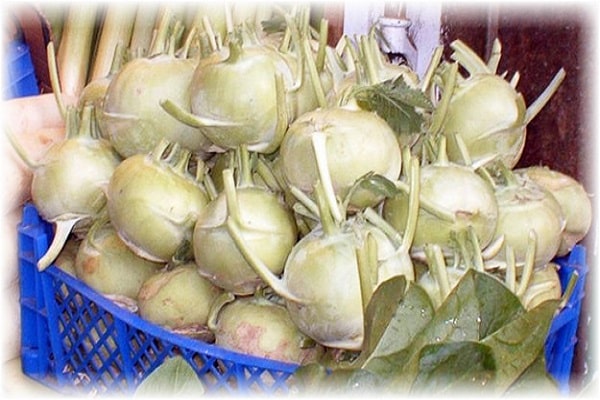
If you cannot find storage boxes, you can sprinkle the floor in the cellar with a layer of sand and stick the heads of cabbage into it so that the stump is at the bottom.It is not necessary to arrange them tightly to each other, let a small distance remain between them. You can hang the heads of cabbage on a rope. The cellar should have a temperature not higher than 0 degrees and high humidity - not less than 90-95%.
- In the freezer.
The cabbage should be peeled and finely chopped. The finished mass is laid out in packages and sent to the freezer. Before packing, the vegetable can be blanched for 3-4 minutes.
